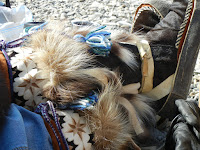 This week I was in Wainwright for a few days. I was facilitating training and staying at an administrator’s house, which is really very nice. So I walked to the local store to get something to drink (those small plane rides make me really thirsty). Not a Diet drink of any kind on any shelf. All full sugar drinks in cans. No plain water, only colored, flavored water. That was a little disconcerting…
This week I was in Wainwright for a few days. I was facilitating training and staying at an administrator’s house, which is really very nice. So I walked to the local store to get something to drink (those small plane rides make me really thirsty). Not a Diet drink of any kind on any shelf. All full sugar drinks in cans. No plain water, only colored, flavored water. That was a little disconcerting…The good news was the store was open. On my ride in from the airport I heard they had closed the day before because they were out of food. I know…you probably think I make some of this stuff up. Incidentally, as we were leaving two days later the sign on the local hotel stated, “Closed after 3:00 p.m. No Help.” No one to work, so they close up shop! That’s life in the village.
 I know I could never live here. Don’t get me wrong, it’s a very lovely little village, but the Internet connection (rather lack of) drives me crazy! I get one little triangle on my wifi status…that’s it. On the other hand, it could be good for curtailing the amount of work I do at home. On the other hand, how would I shop? I don't know how anyone in rural Alaska survived before the online mall. Come to think of it, I do know...I lived rurally before the Internet was widespread. Causes a disease lovingly referred to as STYD (shop till you drop) every time you get Outside!
I know I could never live here. Don’t get me wrong, it’s a very lovely little village, but the Internet connection (rather lack of) drives me crazy! I get one little triangle on my wifi status…that’s it. On the other hand, it could be good for curtailing the amount of work I do at home. On the other hand, how would I shop? I don't know how anyone in rural Alaska survived before the online mall. Come to think of it, I do know...I lived rurally before the Internet was widespread. Causes a disease lovingly referred to as STYD (shop till you drop) every time you get Outside! 
Actually, we are victims of this disease right now as we can't get everything by online shopping. Curiously, there are numerous sites that won't ship to Alaska. I think the state is still considered a foreign country in much of the Lower 48 where most of these vendors are located. But, I digress from the Wainwright trip.
My fellow trainer and I were due to leave on the 5:00 p.m. flight and due to arrive back in Barrow before 6:00 p.m. There is but one local airline that flies to the villages. It is notorious for changing the schedule without notifying anyone. Knowing this, we called them at 4:00 to make sure the flight was leaving as scheduled and were assured the schedule was intact. Keep in mind, there is no one locally and that call went to a Barrow agent while the flight was in the air. Another call at 4:30 reversed that information. "What's that you say? The flight already landed and took off for another village and was on it's way back to Barrow? SERIOUSLY?!!!"
 You see, the pilots make executive decisions mid-flight sometimes...or according to whim...or according to the color of their shirts...or I really don't know how. It doesn't appear to matter whether or not you have reserved seats on a flight...that doesn't have any bearing on whether or not the flight comes in as scheduled, or stops for a freight drop and takes off in a hurry. This is not the first time I've had this happen to me, nor is it the only story one hears of this as one travels around the North Slope. In any case, it was the last regularly scheduled flight for the day.
You see, the pilots make executive decisions mid-flight sometimes...or according to whim...or according to the color of their shirts...or I really don't know how. It doesn't appear to matter whether or not you have reserved seats on a flight...that doesn't have any bearing on whether or not the flight comes in as scheduled, or stops for a freight drop and takes off in a hurry. This is not the first time I've had this happen to me, nor is it the only story one hears of this as one travels around the North Slope. In any case, it was the last regularly scheduled flight for the day.
That was the bad news. The good news was that a charter was coming in to transport the 15 or so participants from our training back to their home village, so we could get seats on that flight. The corresponding bad news was that the charter was going to make three stops before heading back to Barrow. So, what would have been a 35-40 minute flight turned into a "three hour tour." My colleague and I just settled back with our books to enjoy the ride...no peanuts, no drinks, and no lavatories, the latter of which really was the biggest challenge of all!





















































